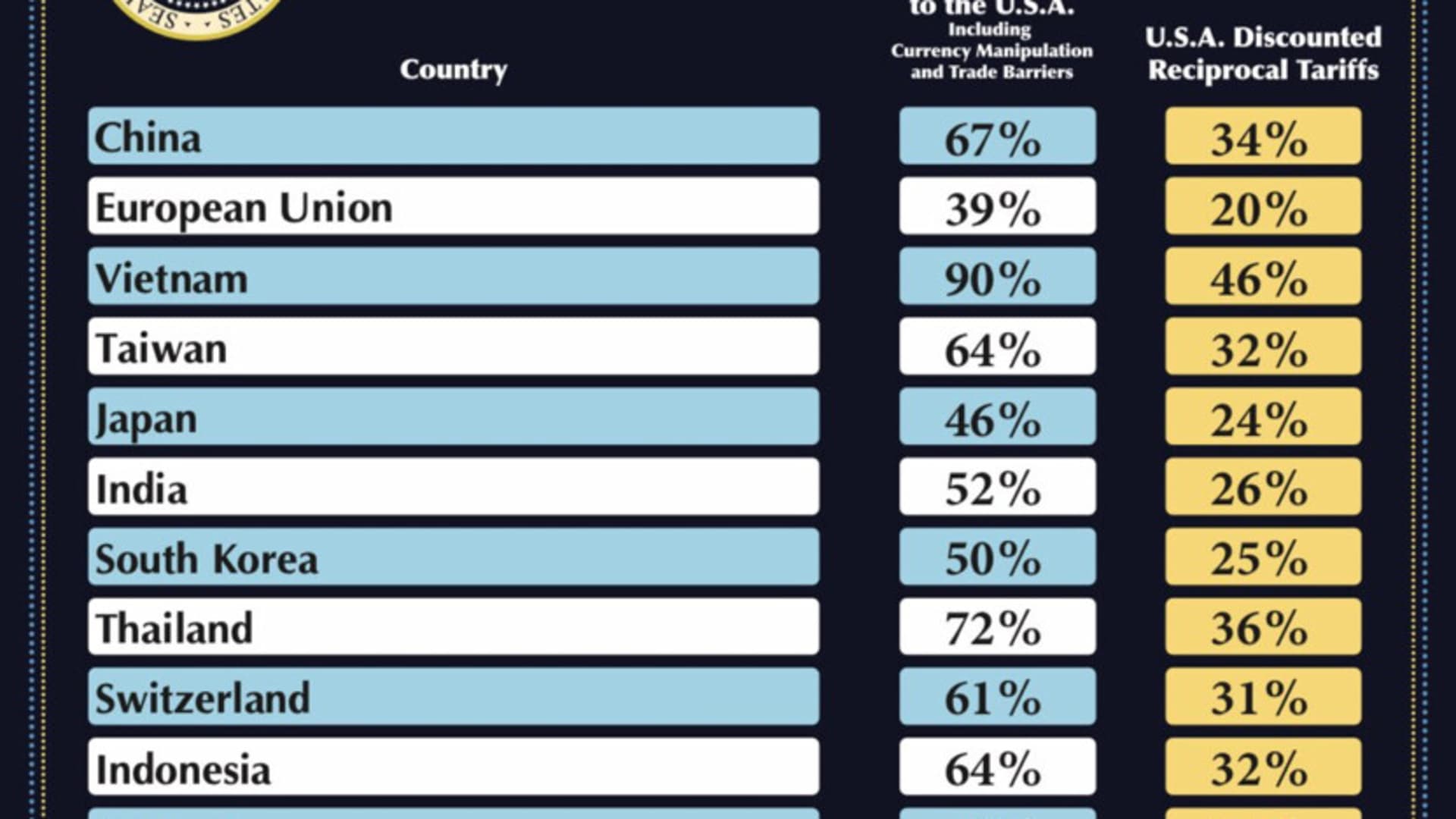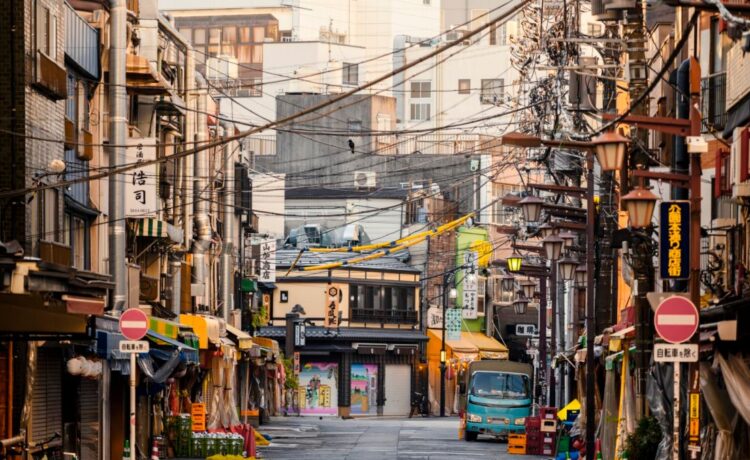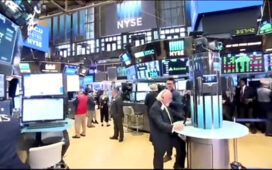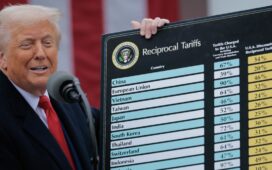This is CNBC’s live blog covering Asia-Pacific markets.
Asia-Pacific markets plunged on Thursday, after U.S. President Donald Trump imposed hefty reciprocal tariffs on over 180 countries and territories – several of which are in the region.
In charts posted on social media, the White House showed the effective tariff rates they claim other countries impose on American goods, including by “currency manipulation and trade barriers.”
The White House told CNBC’s Eamon Javers on Wednesday that the new reciprocal rate on China will be added to existing tariffs totaling 20%, meaning the true tariff rate on Beijing under this Trump term is 54%.
Meanwhile, goods from India, South Korea and Australia face tariffs of 26%, 25% and 10%, respectively.
Australia’s S&P/ASX 200 was down 1.55%.
Japan’s benchmark Nikkei 225 was down 3.02%, paring losses of over 4% at the open, while the broader Topix index was down 3.19%, also paring losses of over 4%.
In South Korea, the Kospi index fell 1.57%, paring losses from over 3% at the open, while the small-cap Kosdaq was down .55%.
Futures for Hong Kong’s Hang Seng index stood at 23,094, pointing to a weaker open compared to the HSI’s Wednesday close of 23,202.53.
Gold prices hit a record high and were trading at $3,156.75 per ounce as at 7.28 a.m. Singapore time, as investors flocked to the precious metal.
U.S. futures cratered as Trump’s sweeping tariffs of at least 10% and even higher for some countries, raised the risks of a global trade war that would adversely affect the already slowing U.S. economy.
Overnight stateside, stocks climbed in yet another volatile session.
The S&P 500 advanced 0.67% to close at 5,670.97, while the Nasdaq Composite added 0.87% and ended at 17,601.05.
The 30-stock Dow Jones Industrial Average added 235.36 points, or 0.56%, and settled at 42,225.32.
Shares of Tesla climbed 5.3%, rising on news that President Trump has signaled to his cabinet that Elon Musk will be stepping back
— CNBC’s Brian Evans and Sean Conlon contributed to this report.
Nissan reportedly suspends part of production line in Mexico; plunges 6%
Japanese automaker Nissan has reportedly suspended part of its production line in Mexico, according to Nikkei.
Nikkei reported that the line has been used for production capacity adjustments, and has been repeatedly operated and stopped in the past. The latest stop was also planned.
Shares of Nissan plunged over 6.2% on Thursday as investors also absorbed tariff news out of the U.S.
— Lim Hui Jie
Japan’s Nikkei 225 opens over 4% lower
Japan’s Nikkei 225 opened over 4% lower on Thursday.
As at 9.26 a.m. local time, the benchmark was down 3.31%.
The Nikkei 225 is down 10.45% since the start of the year.
Among the worst performing stocks were Advantest which lost 4.47%, SoftBank Group, which fell 4.62% and Toyota Motor which was down 3.37%.
Meanwhile, the broader Topix index was down 2.82%.
— Amala Balakrishner
Australian stocks plunge over 2% in early trade
Australia’s S&P/ASX 200 plunged 2.07% as at 10.48 a.m. Australian Eastern Daylight Time, following U.S. President Donald Trump’s fresh tariff rollout.
The index is down 4.62% since the start of the year.
The decline was broad-based across industries, and was led by the materials, energy and consumer staples sectors.
— Amala Balakrishner
Gold prices hit record high on Trump tariff rollout
Gold prices rose to another record high, lifted by developments in the trade war and geopolitical uncertainties.
Gold futures on the Commodity Exchange hit $3,183.60 per ounce.
The bullion is expected to have further room to run as global markets remain on edge, said analysts from Fitch Solutions’ research unit, BMI.
“Gold remains boosted by escalating trade uncertainties, heightened geopolitical tensions, a weaker U.S. dollar, increasing central bank purchases, and rising risks of recession,” said BMI analysts.
—Lee Ying Shan
Here are Trump’s new tariff rates for more than 180 countries
President Donald Trump and the White House laid out the U.S. reciprocal tariff rates that more than 180 countries and territories will face under his sweeping new trade policy.
In charts posted on social media, the White House shows the effective tariff rates they claim other countries impose on American goods, including by “currency manipulation and trade barriers.”
An adjacent column shows the new tariff rates the U.S. will impose on each country or territory, including the European Union. The reciprocal rates are not necessarily the only U.S. tariffs these countries will face.
Trump held up the chart when he unveiled his tariff policy in the White House Rose Garden.

Chart of reciprocal tariffs.
— Kevin Breuninger
Trump imposes a baseline 10% tariff on all U.S. imports
In addition to the sweeping country-by-country tariffs announced today, Trump also imposed a 10% baseline tariff that effectively ensures a tariff on any country that is not among the more than 180 singled out.
“All articles imported into the customs territory of the United States shall be, consistent with law, subject to an additional ad valorem rate of duty of 10%,” unless otherwise noted, the executive order signed this afternoon reads.
Trump also reserves the right to raise this baseline rate “should U.S. manufacturing capacity and output continue to worsen.”
Read the whole executive order here.
— Erin Doherty




